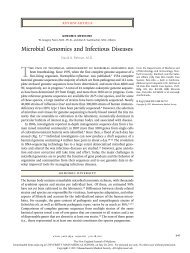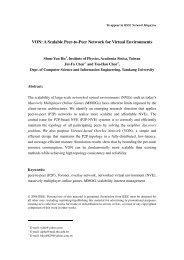3.1 MB - Evernote
3.1 MB - Evernote
3.1 MB - Evernote
You also want an ePaper? Increase the reach of your titles
YUMPU automatically turns print PDFs into web optimized ePapers that Google loves.
38<br />
Parallel Transaction-oriented Simulation<br />
migration of LPs involves a “substantial amount of overheads in saving the process<br />
context, flushing the communication channels to prevent loss of messages”. And<br />
especially on loosely coupled systems with relatively slow communication channels<br />
sending the full process context of the LP from one node to another can add a<br />
significant performance penalty to the overall simulation. This penalty would depend on<br />
the size of the process context as well as the communication performance between the<br />
nodes involved in the migration. The gained performance on the other hand depends on<br />
the difference in processing performance and other workload on these nodes. To<br />
determine reliably when such an automatic migration is beneficial within a loosely<br />
coupled, dynamically changing Ad Hoc Grid environment would be difficult and it is<br />
likely that the performance penalty outweighs the gains.<br />
This work will therefore not investigate the load balancing and automatic LP migration<br />
for performance reasons but only support automatic LP migration as part of the fault<br />
tolerance functionality provided by ProActive and described in <strong>3.1</strong>.3. Manual LP<br />
migration will be supported by the parallel simulator using ProActive tools.<br />
4.7 Model Partitioning<br />
Besides the chosen synchronisation algorithm the partitioning of the simulation model<br />
also has a large influence on the performance of the parallel simulation because the<br />
communication required between the Logical Processes depends to a large degree on<br />
how independent the partitions of a simulation model are. Looking at the requirements<br />
of a general-purpose transaction-oriented simulation system for Ad Hoc Grid<br />
environments in 4.2 the conclusion was drawn that the required communication needs to<br />
be kept to a minimum in order to reach acceptable performance results through<br />
parallelisation in such environments. The communication required for the exchange of<br />
Transactions between the Logical Processes is part of this overall communication.<br />
A simulation model that is supposed to be run in a Grid based parallel simulation system<br />
therefore needs to be partitioned in such a way that the expected amount of Transactions<br />
moved within the partitions is significantly larger than the amount of Transactions that<br />
need to be transferred between these partitions. This means that Grid based parallel
















